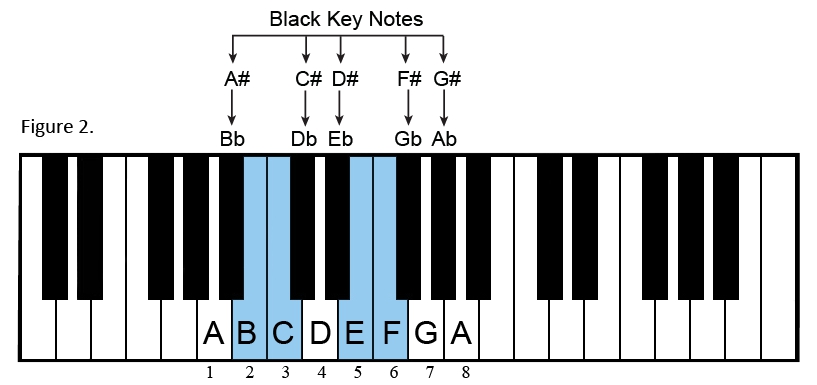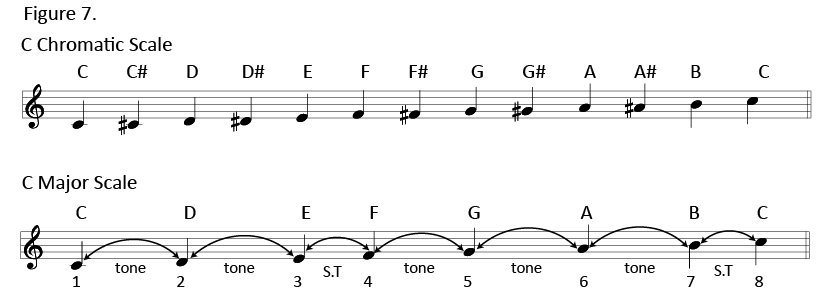The Musical Alphabet Explained
The Natural Notes
The musical alphabet consists of 7 letters – A B C D E F G. These notes are referred to as the alphabet’s natural notes and are represented by the white keys on the piano. See below in figure 1. Counting up the scale 8 letters from ‘A’ to the next ‘A’ note is the distance of one octave.

We can see that there are no black keys between the notes B and C or between E and F notes on the piano. This is due to the fact that the piano was designed around existing musical theory with particular consideration of the C major scale and it’s interval distances. This also created an advantage for fingerings of scales that all look identical in every octave. This was both a physical and visual advantage for playing the piano. We can further expand on this after we’ve looked at the next section on sharp and flat spellings and the chromatic scale.
The Sharps and Flats
The black keys represent the sharp and flat notes in the musical alphabet. The sharp note name’s are spelled using the sharp sign “#”. For instance the “A sharp” note in between the white keys A and B, would be indicated by the note symbol “A#”.
The flat note letter name’s are spelled using the flat sign “b”. In this instance the “B flat” note is indicated with the note symbol “Bb”. Since each black key has two note names representing the same musical pitch, the note A# is the same black key as Bb.
Having two names for the same musical pitch is called an enharmonic equivalent. This is necessary to avoid complicated spellings that would occur if we were to only spell with flats or only spell with sharps. Which spelling is used depends on the key of the music. Some keys are written in sharps and some keys are written in flats which we will cover when we get to key signatures. Take a look at Fig.2 and observe the enharmonic spellings of the black key notes!

Here in figure 3 are all 17 notes in the musical alphabet written on the music staff so that you can see how the sharp and flat accidentals fit in beside the notes.

The Chromatic Scale
A one octave chromatic scale is a sequence of twelve intervals of notes all the same distances apart. That distance is most commonly called a semitone or halfstep. All 12 notes of the musical alphabet are used to complete one octave. Of course it’s not necessary to use both spellings for each of the sharp and flat notes. Because a sharp raises the note one semitone and the flat sign lowers it, we use sharp signs ascending and flat signs descending. This is good practice for writng out chromatic scales because it helps to commit the spellings tp memory.
‘A’ Chromatic Scale Ascending

This scale is called an A chromatic scale because it starts on the note ‘A’ and moves strictly by semitones all the way up to the octave note ‘A’. There is no key centre in a chromatic scale so the use of accidentals are necessary to label the black key notes.
A great way to familiarize yourself with the enharmonic spellings of the sharps and flats and commit them to memory is to spell the intervals as sharps when ascending (going higher in pitch) and use flats when descending (going lower in pitch). Figure 5 shows a descending ‘A’ chromatic scale using the flat spellings.
‘A’ Chromatic Scale Descending

‘C’ Chromatic scale with ascending and descending spellings.

The Assignment
Practice writing out a few one octave chromatic scales on some music paper starting on any of the natural notes. Spell sharps ascending and flats descending for the five black-key notes. If you start on a black-key note then use the sharp accidental to begin and ascend using sharps for the black-key notes. When you reach the octave, rename it as the enharmonic equivalent flat then descend using flat accidentals.
Introduction to Intervals
An interval simply is the distance between two musical pitches measured in semitones and in whole-tones. We have seen so far that the smallest interval distance theoretically is the semitone interval. A whole-tone or whole-step is the equivalent of two semitones.
The next chapter examines all of the diatonic intervals of the major scale. Diatonic refers to only the notes of the major scale without any snazzy chromatic notes added in. That comes a bit later.
Because intervals form the basis of a melody and form the chords in harmony, it is necessary to understand the theory and spellings of intervals entirely and to learn to recognize them by their sound. This is the development of relative pitch which is your understanding of what the ear hears. Relative pitch skill is necessary to learn to reproduce all of these elements on our instruments or with our voices. As well, without a solid working knowledge of Intervals, you won’t be able to interpret things like basic chord symbols – for instance Cadd9 or Bb7#9.
If you were blessed with being born with perfect pitch then you can recognize any pitch and can reproduce it on your instrument the first time every time. Perfect Pitch is a superpower.
The Major Scale
We’ve learned that the Chromatic scale contains only semitone intervals between each note in the scale. In the Major Scale there are just two semitone intervals that occur between adjacent notes. The remaining intervals between adjacent notes are whole-tones. Remember that a whole tone interval is the same distance as two semitones. So in summary there are five whole-tone intervals in the scale and two semi-tones. The total distance between an Octave then is 12 semitones or 6 whole-tones.
If we start with the C chromatic scale in figure 7 then drop the notes with accidentals we will be left with the notes of a C Major scale.
A whole-tone interval is also referred to as simply a ‘tone’ or ‘T’ which we can use here to label the whole-tone intervals of the scale. A semitone will be labeled as simply “S.T”

The notes in a scale are referred to as ‘scale degrees’ and every major scale has the identical pattern of tones and semitones that fall between these degrees of the scale. The semitones always occur between the 3rd and 4th scale degrees and in between the 7th and 8th scale degrees. Remember that the notes E and F in the scale are naturally a semitone apart as well as the notes B and C. Constructing a major scale on any other note of the musical alphabet will require the use of at least one sharp or flat. This of course willthat adjusts the intervals of the scale to meet this specific requirement of intervals.
Major Scale Interval Names
All scales are numbered by their distance counted from the first note of the scale. The first note is referred to as the Tonic and all subsequent notes in the scale are characterized by their position in the scale and by their relationship to the tonic. Each is named for its specific distance. First let’s label the scale in figure 8.

Simple and Compound Intervals
All of the interval names you will ever need to know exist within a two octave range. The interval spellings in that second octave are used in the naming of chords that contain those particular intervals. Only the intervals 9,11 and 13 are used in chord names. The intervals 10,12 and 14 are never used in chord names as it would be redundant to do so. For example the C major chord is just called “C” not “C10” and a power chord is “C5” not “C12”. The Cmajor7 chord is never “Cmajor14” and the C7 chord is never “C14” regardless of the octave that interval is in, it‘s always “7”.

